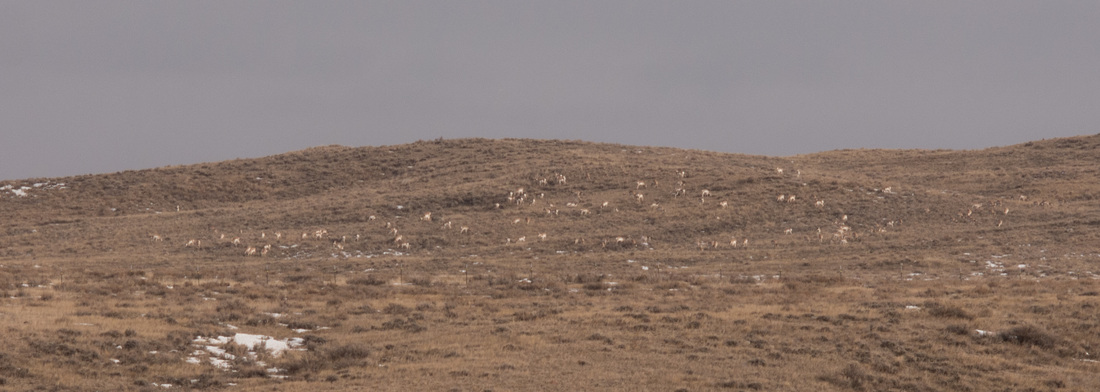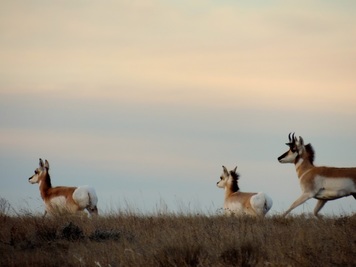|
By Kathryn Davison
Landmark Crew Member |
At first, we thought that the bumps on the landscapes were just rocks. As the temperature drops we’re seeing fewer mammals and reptiles on the American Prairie Reserve, so we wouldn’t have been surprised. So imagine our joy when we looked through the binoculars and realized that the rocks were actually a large group of pronghorn!
The pronghorn, which resembles an antelope with white fur on its rump, seems to be shifting its grouping behavior as we transition to winter. According to one Yellowstone study, mean pronghorn group size increased significantly from fawning in early summer to winter2. At the beginning of fall, we would typically see groups of two to eight pronghorn. Just a couple weeks ago on our Dry Fork transects, we observed large groups of up to 64 pronghorn, and have been spotting large groups since. We’ve noticed that these wintering groups are comprised of mixed ages and sexes, which differed from the harems that the males created during their ruts from September to early/mid-October.
The amount of space, or range, that the pronghorn occupy correlates to the number of pronghorn in the group. A larger range can provide for a larger winter herd. According to a study in South Dakota, winter ranges spread anywhere from about 1500-3,000 acres on average, which is significantly larger than their home ranges during the summer, spring and fall1. One explanation for the large grouping behavior is that it poses decreased individual risk of predation.
While conducting transects we noticed that the herds were very flighty and would bolt away once they caught wind of us, even when we were over 400 meters away. This is not a new behavior, but the increased group size makes it easier for them to spot us from further away.
The pronghorn teach us that, during winter, it’s good to stick together. We are stronger and more aware of our surroundings together than we are apart.
The pronghorn teach us that, during winter, it’s good to stick together. We are stronger and more aware of our surroundings together than we are apart.
Learn about Landmark and other Adventure Scientists projects on our website, the Field Notes blog, and by following us on Facebook, Twitter, and Instagram.
Sources:
1. Jaques, C.N., Jenks, J.A., and Klaver, R.W. 2009. Seasonal Movements and Home-Range use by Female Pronghorns in Sagebrush-Steppe Communities of Western South Dakota. Journal of Mammology, 90(2), 433-441. Accessed at https://dx.doi.org/10.1644/07-MAMM-A-395.1
2. White, PJ, Gower, C.N., Davis, T.L., Sheldon, J. W., and White, JR. 2012. Group dynamics of Yellowstone pronghorn. Journal of Mammology, 93(4), 1129-1138. Accessed at https://dx.doi.org/10.1644/10-MAMM-A-257.1
1. Jaques, C.N., Jenks, J.A., and Klaver, R.W. 2009. Seasonal Movements and Home-Range use by Female Pronghorns in Sagebrush-Steppe Communities of Western South Dakota. Journal of Mammology, 90(2), 433-441. Accessed at https://dx.doi.org/10.1644/07-MAMM-A-395.1
2. White, PJ, Gower, C.N., Davis, T.L., Sheldon, J. W., and White, JR. 2012. Group dynamics of Yellowstone pronghorn. Journal of Mammology, 93(4), 1129-1138. Accessed at https://dx.doi.org/10.1644/10-MAMM-A-257.1



